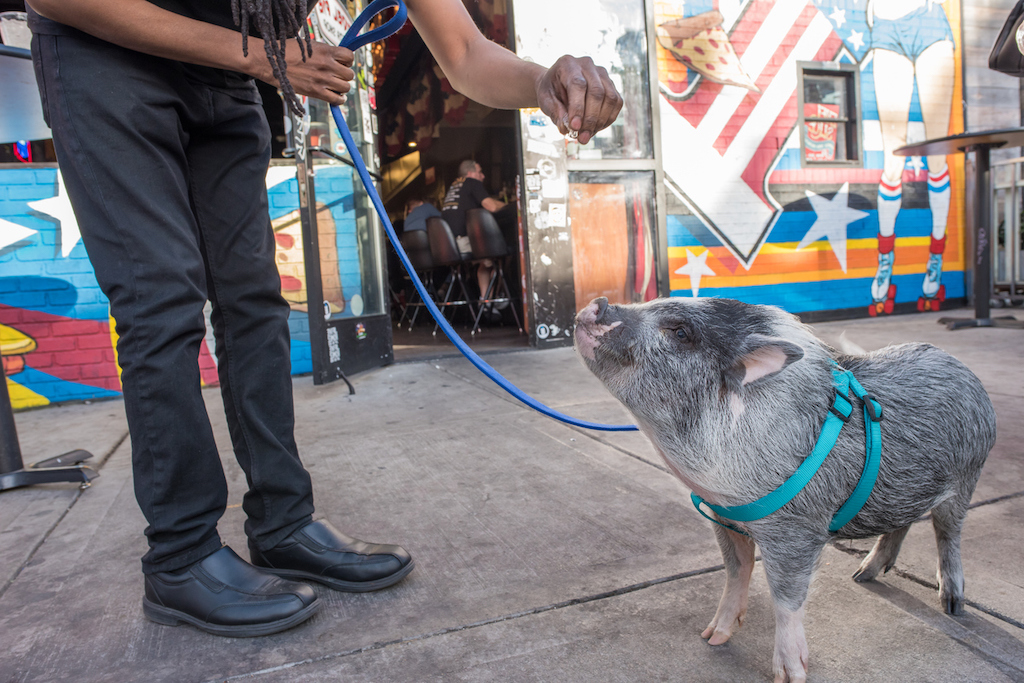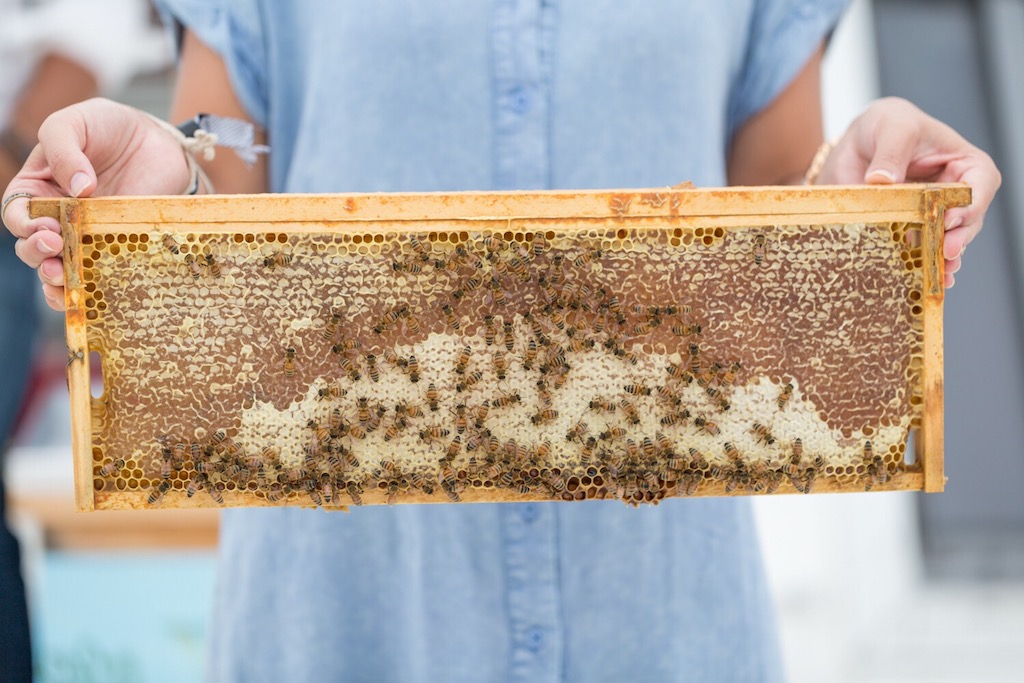
Page Light Studios
UPDATE, May 13, 6:00 PM, EST: The regulation of goats and cattle in Albuquerque, New Mexico has been clarified.
Urban agriculture, in its current incarnation, isn’t going anywhere. Consider some data: There are over 29,000 community gardens in the country’s biggest cities, with hundreds added every year. Americans, many of them city-dwellers, now spend over a billion dollars annually at 8,700 farmers’ markets across the country. And city restaurants are making hyper-local sourcing part of their brands, not to mention institutional buyers like school cafeterias, hotels, hospitals, and universities.
That’s all well and good, and the thought of growing food right in your own backyard might even elicit a warm, pastoral smile—that is, until you get a whiff of that pig poop. In recent years, as city dwellers have embarked on the path of urban farming, along with them have come farm animals, too. Mostly, these urban farmers have been raising chickens—13 million Americans host them in their backyards. But in some cities across America, there are laws on the books allowing for larger beasts, too—like goats in Oakland, California, cows in Charlotte, North Carolina, and pigs in Kansas City, Missouri.
As was the case in other, previous eras of urban farming—such as the victory gardens that sprouted up during World War II—today’s urban-ag movement is dominated by producing fruits and vegetables. But livestock are a big part of it, too. That’s what interests William Butler, an urban planning professor at Florida State University. Butler studies how cities have tried to control local food systems through zoning and land use codes. To him, a stinky, noisy farm animal grazing—and pooping—in someone’s backyard, exemplifies what he sees as the inherent tension of the local food movement: When is enough, enough?
“It’s like: ‘I live in a city. I don’t want to live near a farm. That’s the whole point,’” he says.
Butler says local governments got interested in regulating farm animals within city limits in the late 2000s, as urban farming and local food were undergoing something of a renaissance. Between 2007 and 2010, more than 100 localities added or revised backyard chicken laws, according to a 2011 paper in the Connecticut Law Review, ranging from large cities like New York, New York; Seattle, Washington; Atlanta, Georgia; Portland, Oregon; Nashville, Tennessee; Houston, Texas; and San Francisco, California, to smaller towns and villages across the country. Butler went into the municipal archives looking to catalogue how cities made decisions related to accommodating an influx of backyard chickens.
While he was there, he discovered something unexpected. In some cities, there weren’t yet laws on the books for other, larger animals. Theoretically speaking, this meant that urban livestock was basically legal there. Chicago, Illinois, for instance, which was once America’s preeminent slaughterhouse city, doesn’t ban farm animals of any kind.
Similarly, Albuquerque, New Mexico, which has laws on the books for chickens and rabbits, doesn’t have any regulations for cows, goats, or pigs, according to a New Food Economy review of the municipal code. (The zoning code requires that cows and goats roam on a half-acre lot.) That could be in part because New Mexico is what’s known as a “fence out” state, where it’s the responsibility of property owners, not ranchers, to keep livestock off of their lawns.
Just ask the residents of Rio Rancho, a subdivision just outside Albuquerque’s city limits that borders free-range cattle ranches. Six years ago, during a drought, The Rio Rancho Observer reported that cows started wandering in to graze on nearly archetypal suburban lawns—bright green, with fresh-cut grass. (But no white fence.) The owner of the cattle, Bruce King, was charged with two misdemeanors for the trespass, which carried a $1,000 fine and a year in jail. “We wouldn’t want to see that outcome,” the Observer’s staff wrote in an editorial, because a “fence out” state should benefit, not harm, owners of livestock.
Butler also found newer ordinances, specifically added to accommodate cows and other farm animals. He says planners who were tinkering with the code to allow for chickens had probably taken a closer look at the rest of the animal control codes, too. In Cleveland, Ohio, for example, there had long been laws on the books that permitted as many as two goats, pigs, or sheep per home. After that city’s animal control ordinance was revised in 2009, that was still the case—as long as the home was on a half-acre lot, with 150-foot setbacks.
In those cities that were modifying or adding laws around livestock, a major factor was the constituents who seemed most concerned—or, perhaps, who were most vocal—about changing how Americans think about food. Primarily, by rebuking industrial agriculture. And that applied to meat, too.
Visitors pet baby goats in Great Falls, Virginia, at the Local Foods Impact Conference
As the Chronicle reported, it was that last bit—the butchering—that people said they couldn’t deal with. In 2011, animal rights activists got wind of Carpenter’s homemade, $8 rabbit pot pies, which were made with rabbits she had slaughtered herself. Animal control threatened Carpenter with a $1,000 fine. Two months later, Oakland’s planning department showed up, saying she’d need to pay well over $4,500 in fees to legally sell vegetables on her property.
Slaughter is, among other things, a public health concern. If animals aren’t killed properly, their meat can become contaminated, which can spread pathogens, according to Barbara Finnin, a backyard farming advocate. It’s also a quality of life issue. “Many people keep animals in unsanitary conditions,” a fellow urban gardener complained to radio station KQED, “which increases suffering, odors, predators, and disease.” In Carpenter’s case, some people felt backyard slaughter was cruel—for the animals, and for young children who, they said, could “unwittingly witness rabbits’ throats being slit” in their neighbor’s backyard.
In cities that don’t tolerate backyard slaughter, some lawmakers cite less controversial ecological benefits that the presence of livestock provide. In San Diego, California, a city planner who pushed a successful ordinance for backyard goats said it was to sequester carbon in the soil. Minneapolis, Minnesota, which had for years said no to goats, finally relented in 2018, bringing them in as a pesticide-free alternative to weed the city’s parks. Goats are “highly efficient” at chewing up invasive species like buckthorn, Sheila Regan reported in The Journal. They’re also great for yoga.
Others have argued that animals are a necessary part of a functioning backyard farm ecosystems. Chickens and ducks eat the bugs and snails that destroy other local food sources, like vegetables. “They’re giving nutrients, but they’re also getting rid of all the things that a farmer and gardener don’t want in our garden,” Finnin, formerly the director of Oakland’s City Slicker Farms, told The San Francisco Chronicle.
In some instances, it seems, urban livestock is made legal to accommodate residents who have long farmed on the outskirts of the city, and would otherwise lose their business. In Chattanooga, Tennessee, officials loosened restrictions on its “urban agriculture” zones when landowners on the outskirts complained that they were getting ticketed after having farmed peacefully for years.
Two years ago, the Chattanooga City Council voted to lower the minimum size of a city farm from 20 acres down to five, and to issue permits for smaller lots, opening the door to even more aspiring farmers. Based on the new numbers baked into the zoning code, it’s theoretically possible for someone with five acres of land to farm 100 chickens, turkeys or ducks; 20 goats, sheep, emus or ostriches; and 5 cows, horses and pigs. The idea that onerous urban-ag regulations are getting in the way of otherwise well-functioning businesses has proved potent.
For years, in East Austin, Texas—a historically black neighborhood, now on the verge of gentrification—around two dozen urban farms have had the right to slaughter chickens in their backyards, as long as they keep the practice out of sight. In 2013, the city thought about expanding that right to other neighborhoods. Why? Because, according to a report the city commissioned, tourists spent $1.3 billion on food, every year, when they visited Austin. The dollar value of locally-grown food, by comparison, was literally one-thousandth of that number. “A substantial part of the appeal for visitors is a sense that the food they consume is grown, processed, or provided by a local source,” the report read. The city needed to boost local agriculture to meet that demand.
City officials listened. Today, keeping chickens, bees, and goats is permitted in most residential neighborhoods in Austin, and a resident with an acre of land can sell and kill up to 10 chickens a week. Cows and pigs are allowed, too, in the unlikely event that they’re under 200 pounds.
Other cities cited what they claimed to be the prohibitive expense of applying for permits as the reason to loosen laws around urban livestock. In 2015, Pittsburgh, Pennsylvania passed an ordinance that permitted homeowners and renters alike to raise chickens or goats for $70, replacing an earlier urban agriculture zoning law that charged $340, and required a three-to-four-month hearing process. At the time, a planner remarked, only 13 people had ever obtained an urban livestock permit under that process.
San Antonio, Texas, did the same. After urban farmers pushed the city to eliminate livestock use permits in 2016, residents in any neighborhood can own up to eight chickens, 10 rabbits, and two cows, sheep, or goats, as long as there’s enough space for them, according to a review of the municipal code.
Mudchute City Farm, located in London
Put another way? For some, the rural-urban divide is very real—and they would like to keep it that way.












